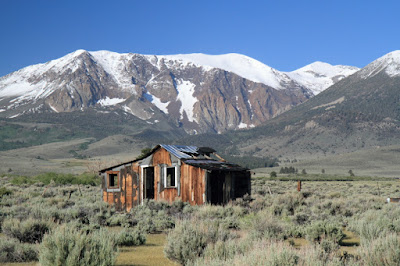It started off as another day manning the Cave Creek Canyon Visitor Info Center; it will be my last time until I come back from the Alaska trip, which will take about 3 months. We do a tally of the number of people who come into the building, whether or not they're visitors, and yesterday we had 15, including the pest control guy who was checking the buildings for pack mice (he didn't find any at the VIC, or at least none that he mentioned to me). Most of the people who come in say something like "Gee, I never realized how beautiful this place is!" Or even "I never knew this place existed!" I'm part of the reason for comments like those is that we're so far off the "beaten path". The only place that you go to from here is the national monument on the west side, and that route isn't paved, so it's not the first choice to get there. THIS usually has to be your destination, and for many people they simply don't know it's here. Hard to believe when you're surrounded by such spectacular scenery. So it's a revelation to most visitors how beautiful this area on the east side of the Chiricahuas is.
But, as most of you know by now, there are some...inconveniences...we may encounter here from time to time. After I came back from the VIC, I was at the computer when I heard a click, looked at the digital phone -- and the connection was lost. The ceiling fans that are constantly on stopped, too. Oh-oh, power outage...It's only happened once before since I moved here, and that lasted a few hours. Since I can't use the landline phone, I call my friends Lori and Mark to see if their power was out, too. "Yep, it's out!" Lori said before she even said hello. My mind thought about things I have to do -- and things I should have done prior to this. Open the refrigerator and freezer only when you have to, so things stay cold or frozen as long as possible. DON'T use the water, or only for essential things; as the well pump is electric, so the only water that's left is what's above ground. And the best way to store that water is to put it in a bathtub. Ordinarily, if the power is out for a long period of time, I could stay in the trailer as it's run on batteries that are constantly charged up by the solar panels, but I let my friends Rob and Deb use it. And heck, the garage door is also electric -- and my truck is in the garage. So I got out the instructions to find out how to manually open it. It wasn't that difficult, but I discovered that top of Tundra's camper shell is too tall for the manually opened garage door; it doesn't lock into place, so when it's rolled up, it keeps sliding down. Well, THAT's not good. I was due over at Mark and Lori's place in about 10 minutes, so I walked over there; it's only about a mile at most. When I arrived, Mark opened the door, and classical music was playing (that's one of the many things we have in common, a love of classical music). The power had gone back on during my walk. Well, at least Mr. Skynyrd didn't have to do an acoustic set because there was no electricity, though out eardrums would have been spared. The concert and time spent there was great -- good food, good beer (called Kilt Lifter, believe it or not), and good friends. And music that took us all back to the 70s, or at least those that were around then. The concert ended fittingly with -- what else? -- "Free Bird".
Yesterday the 26th was a day devoted mostly to watching the wildlife at Faranuf, and the return of the monsoons. (Yes, life during retirement can be tough.) The deer still seem to be skittish when they're approaching the rubber water dish. Check that; the Coues (White-tailed) deer are hesitant to approach it, but the Mule deer go right up to it and drink away. The Coues look at it, then stretch over to drink as if it has cooties; it appears like they're put off by the smell of rubber. But thank goodness the mesquite now has pods as the deer eat that and are less inclined to go for the bird seed.
I had a new visitor to the back yard -- a young Crissal Thrasher. I've heard them sing, but only from a distance, so it was a real treat to see one, especially a juvenile --
I also have 2 Lucy's Warblers; they've been here for about the past 4 days. One is obviously a male, with the rufous red cap --
And I believe this is a young male --
Lucy's are "fairly common" here in summer, and I had one in the back yard last year, though I only got a quick glimpse of it. It's uncommon, so a real treat, to have any warblers here in my back yard.
Mr. Blue Grosbeak continues to look spectacular, and I see him frequently with his missus --
I had an early dinner and spent the rest of the evening out on the front porch, watching the cloud display from the monsoonal flow. It's both complex and dramatic --
The complexity lies in the variety of phenomena you can see at any given moment. For instance, here are sunlit clouds, rays from the setting sun, and a sliver of a rainbow --
And the critter cam looking at the water feature continues to entertain. This is the first time I've seen a javelina there at night, and he made a memorable entrance. Be sure to have the sound on..





























































